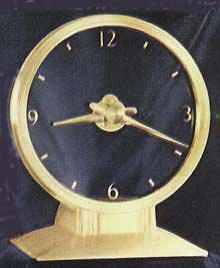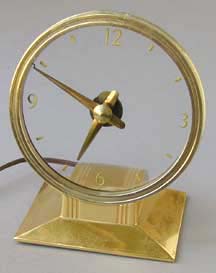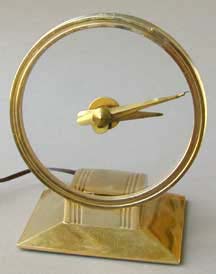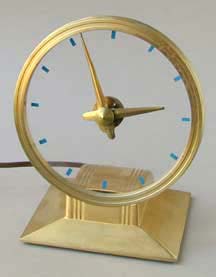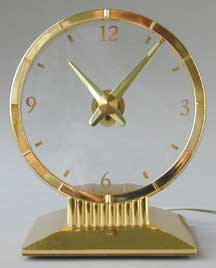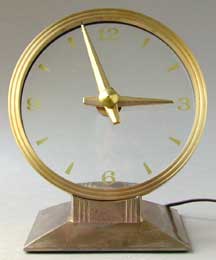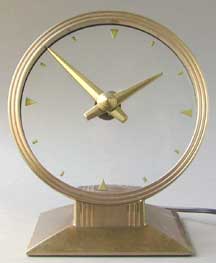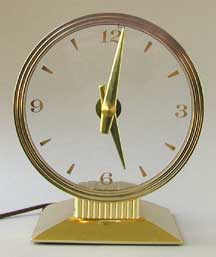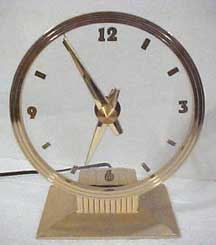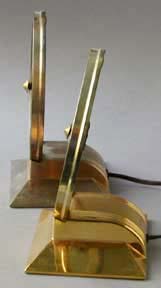Haddon Mystery Clock Variations
by Roger Russell
Copyright 1996-2004 by Roger Russell
All rights reserved
No portion of this site may be reproduced in whole or in part
without written permission of the author.
Old Haddon mystery clocks are
sometimes hard to identify. We might assume the clock we find is genuine and
all the original parts are there. However, on occasion, other parts can be
substituted as in the case of a broken dial glass. Other times, the parts can
be genuine and original to the clock but were probably factory errors such as
the wrong name on the base plate.
![]()
|
|
|
|
As a reference, I have used this picture (shown at the left) from a
catalog to illustrate what the Golden Visionette is supposed to look like. At the right is a photo of what I believe to be an authentic Golden
Visionette complete with the correct base plate. The glass has Arabic
numerals at 3, 6, 9 and The outer ring has two concentric grooves. The base pedestal has a set
of three grooves on either side in the front and rear. It has a face that is 6-1/4" in
diameter. The base is 5-3/8" wide and 4-1/4" deep. |
|
![]()
|
|
In this Visionette, the original glass had probably been broken and
replaced with clear glass. No holes were cut in the center to mount the hand
assembly. Instead, the disc holding the hand assembly is glued to the glass.
The owner was apparently not able to get holes drilled or have the numerals
and lines etched and painted gold like the original manufacture. |
|
|
|
|
|
Here's another Visionette where the glass was also likely broken. The
replacement is unique having a clear plastic disc as a substitute. The hours
are indicated by the blue rectangles that are glued to the rear of the
plastic. |
|
|
|
|
|
The Sun Gold'n Hour normally has plain glass. The hours are marked with
radial lines on the outer ring. Here's one with Visionette glass complete
with numerals and rectangle markings. It would seem redundant to have the hours indicated both on the ring as
well as the glass. Whether this originated at the factory or was substituted later is not
known. |
|
|
|
![]()
|
|
|
|
|
|
|
|
|
|
|
|
|
The Special Vision at the right has different numerals. I know of one
person who had a broken glass replaced and had custom gold lettering put on
by a professional. Is this what happened here? |
|
![]()
The plates may be made of cardboard, fiberboard, molded plastic or
0.025" steel. The information is printed on them. Several Special Visions
have brown cardboard, which is blank. The cardboard plates have circular dents
in the four corners to serve as feet. The others have felt pads. The steel base
plates have gold colored paint with black lettering.
The Haddon Golden Visionette,
Golden Secretary Model 80-S, Sun Gold'n Hour and Commodore all have the same plate
dimensions. They can be interchanged. When I first saw this error, I had
thought the owner or a service person had accidentally mixed up them up.
However, I continue find more of these errors. It now seems more likely that
this occurred at the factory.
|
Clock |
Name On Base Plate |
|
Golden Visionette |
Golden Visionette Model 80 |
|
Golden Visionette |
Commodore Model 85 |
|
Golden Visionette |
Sun Gold'n Hour |
|
Sun Gold'n Hour |
Golden Visionette Model 80-S |
|
Sun Gold'n Hour |
Sun Gold'n Hour with wording
under the gold paint of Golden Visionette Special Model 80-S. On the other
side of the plate is Golden Secretary Model No. 80-S |
|
Special Vision |
Special Model 70S |
![]()
|
|
Many Haddon mystery clocks have the face angled back but some don't.
Here are two versions of the Visionette. The face on this clock is normally
found angled back by about 10 degrees but one has been found that stands
vertically. It's most likely factory made. The Commodore has an identical base and is also angled by 10 degrees. The Golden Vision clocks are angled back about 23 degrees. |
![]()
Which Clock is Which?
As a result of the confusion with the base plates and glass, identification
becomes difficult for some of the clocks. In addition, the special models with
an S after the model number may come in several different versions. Here's a
list of some of the common ones. Base Lines refer to the number of vertical
lines on the pedestal up to the outer ring.
|
Name |
Model |
Dial |
Glass |
Base |
Face |
Remarks |
|
Golden |
80 |
6-1/4" |
3, 6, 9, 12 plus |
3 left |
10 |
Left and right lines continue on back of pedestal |
|
Sun Gold'n |
none |
6-1/4" |
None |
10 |
10 |
Hour lines on ring |
|
Sun Gold'n |
none |
6-1/4" |
Bowling figure painted in gold on the reverse side. |
10 |
10 |
Hour lines on ring |
|
Commodore |
85 |
6-1/4" |
3, 6, 9, 12 plus |
3 left |
10 |
7 spokes on ring. |
|
Golden |
70 |
7-3/4" |
triangles & small |
3 left |
23 |
light & switch |
|
Golden |
70 |
7-3/4" |
3, 6, 9, 12 plus |
3 left |
23 |
light & switch |
|
Golden |
70 |
7-3/4" |
Triangles and tapered marks |
11 |
23 |
light & switch |
|
Golden |
70S |
7-3/4" |
3, 6, 9, 12 plus |
11 |
3 |
|
|
Special |
none |
7-3/4" |
3, 6, 9, 12 plus |
11 |
0 |
light & switch |
|
Special |
none |
7-3/4" |
3, 6, 9, 12 plus |
11 |
0 |
No name on base |
|
About This Site |
||
|
|
More text and pictures about Haddon will be added as my research continues. Any comments, corrections, or additions are welcome. |
|
|
|
|
Created by Roger Russell |
